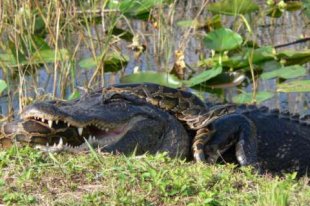Burmese python VS alligator
 Courtesy U.S. Geological Survey/photo by Lori Oberhofer, National Park Service
Courtesy U.S. Geological Survey/photo by Lori Oberhofer, National Park Service
A Burmese python and an alligator fight in the Florida Everglades. The snakes are native to India and Southeast Asia, but they've established themselves in the wetlands of southern Florida, where they're causing havoc with local wildlife
Burmese pythons are eating machines. An adult snake can grow to nearly 20 ft., and it can eat everything from raccoons to bobcats to deer to alligators, killing its prey by constriction and then swallowing them whole. On the jungle food chain, Burmese pythons rest near the top.
Burmese pythons are also — as the name might suggest — not local to the U.S. But they are a popular pet, imported to this country from their native habitat in India and Southeast Asia. And sometimes those pets escape from their owners or are simply let go — especially in Florida, a nexus of the imported wildlife trade and one of the few parts of the U.S. with a climate and landscape to which the pythons can easily adapt. That’s how hundreds or even thousands of Burmese pythons have managed to establish themselves in the Florida Everglades — the vast protected wetlands in the southern Florida — where they’ve become a persistent challenge for local officials tasked with protecting endangered wildlife.
Now a new study published in this week’s Proceedings of the National Academy of Sciences (PNAS) suggests just how big a threat the invasive Burmese pythons have become. Researchers led by Michael Dorcas of Davidson College in North Carolina looked at the distribution of mammals in the Everglades nearly 20 years ago — before Burmese pythons established themselves in the area — and then more recently. They found a drastic reduction in the number of small mammals that are typically part of a python’s diet, and they also discovered that the remaining mammals tend to be most abundant in areas that are either clear of pythons or where the snakes have only recently been spotted. The evidence is strong enough to suggest that invasive Burmese pythons are causing significant wildlife loss in the Everglades — and that the problem could worsen as the snakes continues to grow.
(MORE: Lake Invaders)
Any snake population — you are only seeing a small fraction of the numbers that are actually out there. They are a new top predator in Everglades National Park — one that shouldn’t be there.
We have documented pythons eating alligators, we have also documented alligators eating pythons. It depends on who is biggest during the encounter.
While the snakes have been spotted in the Everglades for at least the past 20 years, they were only recognized as fully established in 2000. Wildlife officials have tried to remove the snakes — 400 were taken out in 2009 — but the damage may already be done. The PNAS researchers looked at data from detailed nighttime road surveys of the Everglades between 2003 and ’11, and compared that data with similar roadkill surveys taken between 1993 and ’99 and road surveys done in ’96 and ’97. They found:
You might also like



|
Wild Republic Stuffed Animal Snake Burmese Python 54 Inch Class Toy (Wild Republic)
|

|
Aurora Plush 50" Albino Burmese Python Jungle Toy (Aurora World, Inc.)
|






